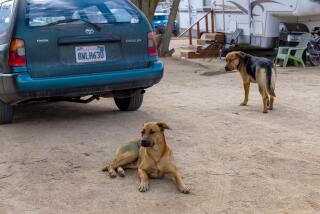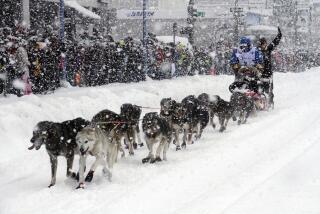TRAVEL INSIDER : Dog Sledding Business Snowballs for a Reason : Dashing through a winter wonderland led by a team of canines promises exhilaration without the unnatural noise of machines. But it comes with a steep price.
- Share via
The meadow lay blanketed in fresh snowfall. The wind sang through the trees. The sled groaned around a bend. And in the path up ahead, Goliath, Uno and 10 other huskies and malamutes panted steam clouds into the cold wind and leaned into their harnesses to drag me home. It was over too soon.
That morning, about a month ago, was my first dog sled ride. Afterward, the 27-year-old musher who held the reins behind me confessed that it was his first, too.
“I call my friends back home and say, ‘I’ll give you 200 guesses what I’m doing.’ ” he told me. “And by 307, they still haven’t got it.”
But my musher and I seem to be running behind the trendsetters in these matters.
Dog sled businesses have arisen in winter resort areas across the country. No one seems to be sure exactly how many, but I found companies in Alaska, California, Colorado, Montana, Minnesota and Wyoming.
“It’s just gone nuts. I don’t know what the deal is,” says Bill Snodgrass, who has been running dogs near Jackson Hole for three years. “We get 10 times as many calls for dog rides now as we do for snow machine tours.”
Needing snow, most dog sled companies operate on the same schedule as ski resorts, vying with hot-air balloons, bobsleds and others for the off-slopes time of skiers. Each has charms; the dog-sled folk promise the exhilaration of sliding through a snowscape, the quiet of a machine-free journey and the companionship of working dogs.
Rides can range from 30 minutes to four days or more. Most operators rely on about a dozen dogs to haul two seated customers per sled. The musher stands in back, handling reins and barking “hike!” to urge the animals forward.
There’s no whipping, and nobody ever says “mush”--it’s “gee” to turn right, “ha” to turn left, “whoa” to stop. The word “mush” apparently dates back to an English-speaker’s misunderstanding of a French-Canadian’s command to marche --to walk.
At the midpoint in my ride, which took place in Eagle, Colo., the crew offered hot chocolate and fresh pumpkin bread. Other outfitters offer full meals, or overnight stays in wilderness lodges; some will teach customers how to pilot a sled.
My rookie musher, Peter Haverson, formerly of Buckinghamshire, England, was closely watched by William “Wally” Glass, proprietor of Mountain Musher Dog Sled Rides (P.O. Box 1386, Eagle, Colo. 81631; 303-328-6500). Glass, is a 36-year-old former truck driver with a red moustache and long sideburns that, at the end of a ride, had ice dripping from them. He and his wife, Denise, have been at the business for four years, depending mostly on erstwhile skiers from nearby Vail. In the last two years, the Glasses say, interest seems to have risen sharply.
“Smashing!” proclaimed British tourist Bill Ives after his jaunt over the hills and through the meadow on the morning of my visit. The bill was $400 for his family of four, but that hardly gave him pause.
“You’ve got to do these things,” said Ives, a stock speculator from outside London, as he watched the mushers unharness the tussling and yelping dogs and lead them back to their pens.
The ride prices may seem steep. But since the dogs don’t work in warm weather, it’s only a seasonal enterprise for most entrepreneurs. Glass holds down a summer job to make ends meet, and stitches dog wounds himself to save veterinarian bills.
Over generations, sled dogs have been bred to be docile and affectionate among humans, yet aggressive and physical with other dogs. Glass reports no bitten or injured customers so far. Paul Marvelly, who runs dogs in Mammoth, sometimes puts husky puppies in the laps of young customers.
One reason for sledding’s rising profile could be the attention that competitions have gotten in recent years. Steve Dickstein, a field investigator for the Humane Society of the United States, which has called for reforms in the running of Alaska’s 1,100-mile Iditarod, the most famous of sled dog events, said his organization “has not taken a real close look” at short-distance commercial dog sled operations and whether they harm animals.
Outside Alaska, veteran dog runners say the oldest, biggest sled dog operation in the Lower 48 is Krabloonik, of Snowmass Village, Colo., near Aspen. (P.O. Box 5517, Snowmass Village, Colo. 81615; 303-923-4342). The business dates back to 1974, when founder Dan MacEachen, a veteran Iditarod competitor, was given 50 dogs by veteran dog sled operator Stuart Mace. MacEachen named his company for his first lead dog (in one of the Eskimo languages, it is said, krabloonik means “bushy eyebrows” or “white man”).
Now there are 250 dogs in the kennel, and the Krabloonik restaurant has been running since August, 1982, offering lunches and dinners in the winter, dinners in the summer. (The menu has included elk, caribou, wild boar and moose.) A two-hour, 8-mile ride--lunch at the restaurant included--costs $175 per adult.
Here is an unscientific sampling of dog sled operations in other states:
California: Paul Marvelly, a 38-year-old New Zealander, has run Dog Sled Adventures (P.O. Box 7791, Mammoth Lakes, Calif. 93546; 619-934-6270 or through the Mammoth Adventure Connection at 619-934-0606) since 1987, building his own sleds of oak and hickory. He runs 32 dogs, and offers a 25-minute sled ride (just over a mile) for $35 per adult, $19 for children 12 and under, free for children under 3 accompanied by parents. One-hour rides run $60 per adult; ride-and-dinner packages run $73 (if the meal is at the Mountainside Grill of the Mammoth Mountain Inn) or $65 (if the meal is at The Yodeler, a more family-oriented restaurant also at the inn).
Alaska: Roger Bliss, a former Iditarod competitor who lives 45 miles north of Anchorage, has been running dogs commercially for 10 years (Mush Alaska, P.O. Box 871752, Wasilla, Alaska, 99687; 907-376-4743). He keeps 25 dogs--though he has access to more--and this year will offer tours from Jan. 15 to March 31. Packages include half-hour trips for $35 per person and overnight trips offering panoramic views of Mount McKinley. Prices for a two-day trip, with meals and lodging in a wilderness cabin, begin at $375 per person.
Minnesota: Arleigh Jorgenson has been racing sled dogs for 25 of his 46 years. Six years ago, he decided he “had to put a financial base underneath what I was doing.” His first venture--15-minute rides at the foot of Lutsen, Minnesota’s ski slopes--has grown into business (Arleigh Jorgenson Sled Dogs, Box 667, Star Route 1, Grand Marais, Minn. 55604; 218-387-2498) with 97 adult dogs, a network of trails from his kennel in Grand Marais, in the northeast corner of Minnesota, and a wide variety of offerings. One-hour sessions fetch $70 for a couple, $50 for a single; a four-night, lodge-to-lodge journey of about 120 miles runs $840 per person, meals and accommodations included).
Montana: For three years, Jeff Ulsamer and Carol Bloodworth have run Dog Sled Adventures (Box 34, Olney, Mont. 59927; 406-881-2275), about 20 miles north of Whitefish and 25 miles north of the Big Mountain ski area. (Before that, Bloodworth says, Ulsamer ran dogs in Colorado for 11 years. The business includes 50 dogs, and prices run $85 a couple for a 1 1/2- to 2-hour ride, $150 for one twice as long. The longer route includes an igloo stop for a hot drink.
Wyoming: At least three operators are said to be offering dog sled rides within a day’s drive of Jackson Hole. One of them is Washakie Outfitting (Box 1054, Dubois, Wyo. 82513; 307-733-3602), 75 miles northeast of Jackson Hole. Owners Bill and Jackie Snodgrass have been running dogs there for three years, using their 30 Alaskan huskies to complement summer and fall pack tours and big-game hunting excursions. Prices for two-hour tours begin at $55. For $300, customers can ride all day, have dinner, spend the night in a mountain cabin and ride back for brunch at the starting point--about 30 miles on the trail in all.
More to Read
Sign up for The Wild
We’ll help you find the best places to hike, bike and run, as well as the perfect silent spots for meditation and yoga.
You may occasionally receive promotional content from the Los Angeles Times.







